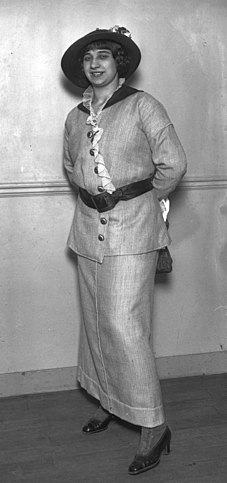Sometimes Francine Prose’s Lovers at the Chameleon Club, Paris 1932 feels as changeable and fickle
as its cross-dressing and border-crossing characters: despite the hours spent
reading this 400-plus-page book with multiple narrators, I’m still not quite
sure if I read a social commentary, a character sketch of a maligned woman gone
bad, a World War 2 novel, or something else. It wouldn’t be difficult to
generate a list of at least another dozen possibilities. The strength of Lovers is that it presents a broad and fairly
engaging picture of Paris in 1932 and beyond, complete with fictional versions
of Violette Morris, Brassaï, and Henry Miller, though that
strength creates a weakness, too: the broadness left me wishing Lovers had been a little sharper, a little more difficult, and a little
more uncomfortable. Actually, I wish it had been a lot more uncomfortable. I
seem to appreciate uncomfortable books.
 | |
| Violette Morris, 1913 |
Prose’s letter to readers in my review copy of Lovers begins by noting that the idea
for the novel came from Brassaï’s photograph “Lesbian Couple at Le Monocle,
1932”: the woman on the right in the photo is Violette Morris, a French
athlete, race car driver, and collaborator with Germany during World War 2. In Lovers at the Chameleon Club, Morris
morphs into Lou Villars, and Le Monocle is replaced with the Chameleon Club, a
place where men dress as women and vice versa. Villars works there and Gabor
Tsenyi, the Brassaï stand-in, frequents the place, as does his eventual patron
Lily de Rossignol, whose husband owns a motorcar company. There’s chameleon-like
behavior all around.
Prose hands the narrative off to her main characters: notably,
Gabor writes letters home to his parents; we get bits of books by Lionel Maine,
the Miller stand-in; memoir material from Suzanne Dunois Tsenyi that was
supposed to be destroyed “on occasion of its author’s death” is published; and Lily
de Rossignol tells all in A Baroness by Night.
There are also chapters from The Devil
Drives: The Life of Lou Villars, written by a certain Nathalie Dunois, who
shares a surname with Suzanne. All these accounts combine to create what inevitably becomes a mosaic of the narrators’ varied political, social, and sexual
passions and alliances. The accounts sometimes coincide and sometimes vary but if
I were to place one character at the center of the book, it would be Lou
Villars, who transforms from merely a sad character who’s gone through family
difficulties and a disappointing romance with a lovely but treacherous dancer,
Arlette, (her partner in the fictional version of the Brassaï photo), to, as I wrote
above, a Nazi collaborator. Lou even has a star-struck dinner with Hitler in
1936, when she takes a trip to Berlin for the Olympics.
The numerous voices combine nicely, sometimes even
humorously, creating a nearly polyphonic novel. Still, I came away from the book—which
I enjoyed and which I think is structurally and thematically fairly sound—thinking
that truth truly is stranger than fiction and that Lovers at the Chameleon Club felt a little too cautious, a feeling
I often get when I read fiction based on fact. I had a similar reaction to Laurent
Binet’s HHhH,
which features Reinhard Heydrich; Heydrich gets a cameo in Lovers, too. By contrast, Romain Slocombe’s Monsieur
Le Commandant: A Wartime Confession, another World War 2 novel I read
earlier this year, felt particularly vivid because it was so horribly uncomfortable
inside fictional the Petainist narrator’s brain. And therein, I suspect, lies my small misgiving about Lovers at the Chameleon
Club: Lou Villars, the collaborator, is one of the lovers in the novel’s title
but the reader never quite gets to the depths (or heights) of her story because
its telling is outsourced to other characters, all with ulterior motives and information
deficits. I realize there are messages there, too—about the unknowable, about truth(s), and about memory—but
still can’t help but feel a sense of missed opportunity and a wish for
something much darker.
Disclaimers: I received
a review copy of Lovers at the Chameleon
Club from publisher Harper Collins. Thank you very much!
Up Next: Roberto Bolaño’s
puzzlingly pleasurable Distant Star
and Ingrid Winterbach’s ominously eerie The
Elusive Moth.
Photo: Public
domain photo
(copyright has expired) of Violette Morris from Bibliothèque nationale de
France, via Wikipedia.
